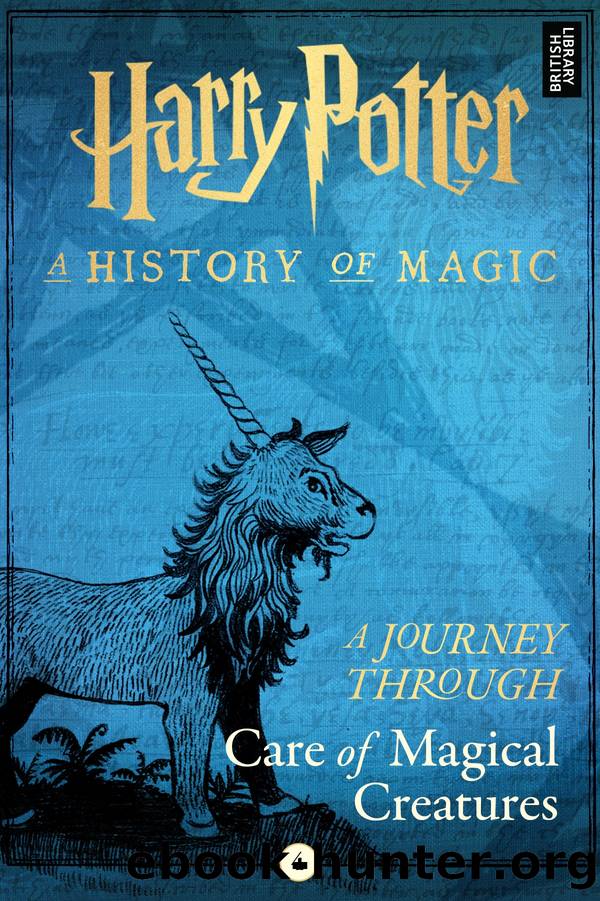A Journey Through Care of Magical Creatures by Pottermore Publishing

Author:Pottermore Publishing
Language: eng
Format: epub
Publisher: Pottermore
At the beginning of the 18th century, a man called Samuel Fallours, an English-born ex-soldier, ended up on the Indonesian island of Ambon while working for the Dutch East India Company. He spent a long time on the beach, along with other artists. He painted the fish he saw in the hauls of the local fishermen, then sold his artwork to the rich. He found that the more brightly coloured the fish, the better the price.
So as time went by, the paintings became more elaborate: a plain, drab false-stone fish was made resplendent in vivid reds, yellows and blues; the shell of a crab was decorated with the moon; fish skins had brightly coloured stars, and some had human faces. There were seahorses replete with itty-bitty saddles for riding. And he included some equally fanciful descriptions, such as one of the four-legged anglerfish, which followed him around like a dog, and of the lobster that lived in the trees.
Then, in 1719, Louis Renard, a book-dealer, apothecary and spy based in Amsterdam (who sounds like he could very well have kept a shop in Diagon Alley), published the world’s first book on fishes from the waters of the East Indies. It was called Fishes, Crayfishes and Crabs, of Diverse Colours and Extraordinary Form, That Are Found Around the Islands of the Moluccas and on the Coasts of the Southern Lands and was illustrated in full colour with Fallours’ artwork.
In the end, the book contained pictures of over 415 fish, 41 crustaceans, two stick insects… and one mermaid. Supposedly caught off the coast of the Indonesian island of Borné, and measuring 59 inches in length, she reputedly lived in a tank of water for four days and seven hours and occasionally cried like a mouse. According to Renard, she refused to eat, despite being offered small fish.
When the book was published, the public questioned the accuracy of the eccentrically portrayed sea life, even with the affidavits attesting to the reality of the specimens Renard had included. And while people were rightly dubious, some scientists are now re-evaluating the scientific worth of the book. Minus the wild colouring, over 90 per cent of the fish can still be identified and, since Ambon’s harbour has become heavily polluted, the type of fish in the area may have changed, in which case this whimsical book will have become a valuable record. It might just be that the mermaids have simply moved on to cleaner waters!
Download
This site does not store any files on its server. We only index and link to content provided by other sites. Please contact the content providers to delete copyright contents if any and email us, we'll remove relevant links or contents immediately.
Whiskies Galore by Ian Buxton(40476)
Introduction to Aircraft Design (Cambridge Aerospace Series) by John P. Fielding(32344)
Rewire Your Anxious Brain by Catherine M. Pittman(17598)
Craft Beer for the Homebrewer by Michael Agnew(17453)
Cat's cradle by Kurt Vonnegut(13879)
Sapiens: A Brief History of Humankind by Yuval Noah Harari(13067)
The Tidewater Tales by John Barth(12035)
Leonardo da Vinci by Walter Isaacson(11912)
Underground: A Human History of the Worlds Beneath Our Feet by Will Hunt(11264)
The Radium Girls by Kate Moore(10914)
Thinking, Fast and Slow by Kahneman Daniel(10611)
The Art of Thinking Clearly by Rolf Dobelli(8858)
A Journey Through Charms and Defence Against the Dark Arts (Harry Potter: A Journey Throughâ¦) by Pottermore Publishing(7996)
Mindhunter: Inside the FBI's Elite Serial Crime Unit by John E. Douglas & Mark Olshaker(7844)
Wonder by R. J. Palacio(7067)
Turbulence by E. J. Noyes(7049)
Tools of Titans by Timothy Ferriss(6956)
Change Your Questions, Change Your Life by Marilee Adams(6653)
The Complete Stick Figure Physics Tutorials by Allen Sarah(6644)
